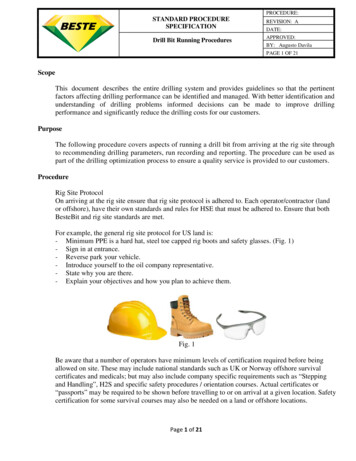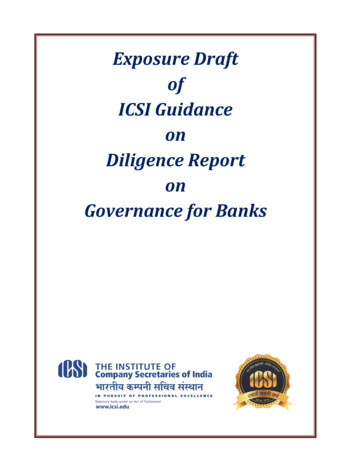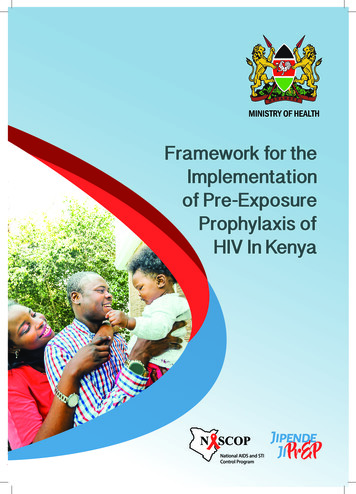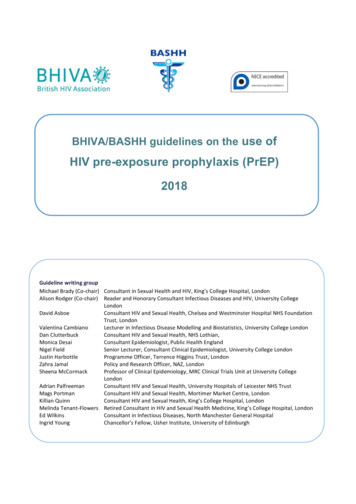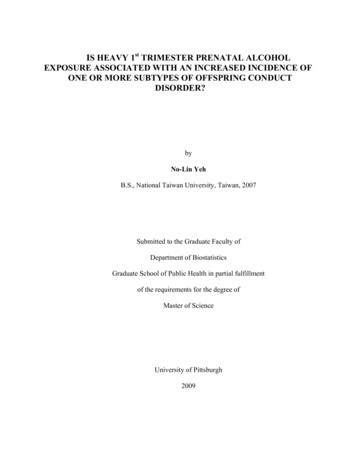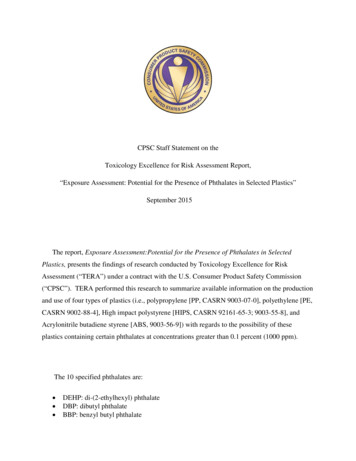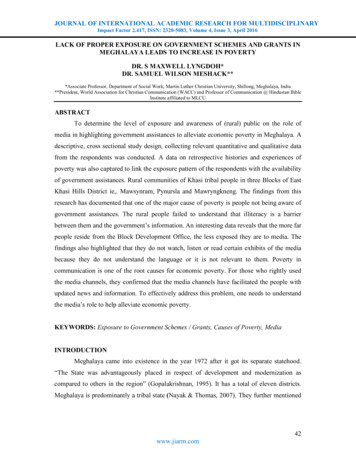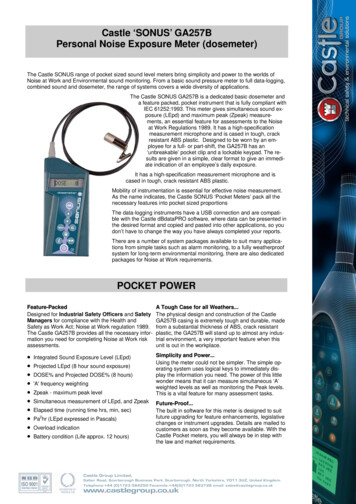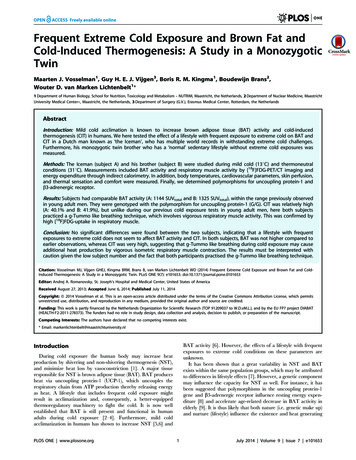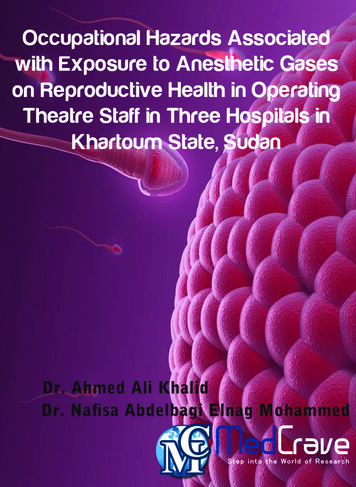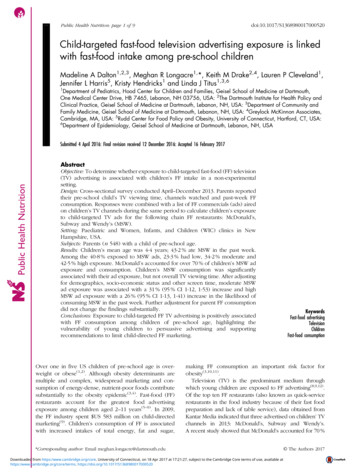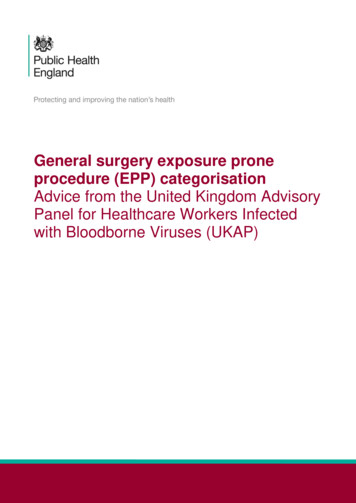
Transcription
General surgery exposure proneprocedure (EPP) categorisationAdvice from the United Kingdom AdvisoryPanel for Healthcare Workers Infectedwith Bloodborne Viruses (UKAP)
General Surgery Exposure Prone Procedure (EPP) CategorisationAbout Public Health EnglandPublic Health England exists to protect and improve the nation’s health and wellbeing,and reduce health inequalities. We do this through world-leading science, knowledgeand intelligence, advocacy, partnerships and the delivery of specialist public healthservices. We are an executive agency of the Department of Health and Social Care,and a distinct delivery organisation with operational autonomy. We providegovernment, local government, the NHS, Parliament, industry and the public withevidence-based professional, scientific and delivery expertise and support.Public Health England, Wellington House, 133-155 Waterloo Road, London SE1 8UGTel: 020 7654 8000 www.gov.uk/pheTwitter: @PHE uk Facebook: www.facebook.com/PublicHealthEngland Crown copyright 2019You may re-use this information (excluding logos) free of charge in any format ormedium, under the terms of the Open Government Licence v3.0. To view this licence,visit OGL. Where we have identified any third party copyright information you will needto obtain permission from the copyright holders concerned.Published: January 2019PHE publicationsgateway number: 2018746PHE supports the UNSustainable Development GoalsPage 2 of 26
General Surgery Exposure Prone Procedure (EPP) CategorisationContentsAbout Public Health England2Executive summary4Exposure Prone Procedures (EPPs)5General Surgery EPP CategorisationsBreast7Endoscopic and laparoscopic gastro-intestinal tract EPP categorisation9Abdomen (excluding urinary and reproductive organs)11Transplant25Contributors26Please note robotic procedures should be categorised the same as laparoscopicPage 3 of 26
General Surgery Exposure Prone Procedure (EPP) CategorisationExecutive summaryThis exposure prone procedure (EPP) categorisation list is not exhaustive of allprocedures carried out in general surgery, but is to be used as a guide only. Individualvariation between surgeons does not allow for a higher EPP risk category to beincorporated in a personal interpretation of a procedure.If any procedures in this document are semi-laparoscopic, when the hand is insertedinto the abdomen via skin incision, then the procedures would certainly be categorisedas EPP level 2, or possibly 3. Laparoscopic assisted procedures are likely to be EPPlevel 3. Robotic procedures should be categorised the same as laparoscopic.In any case of uncertainty about any of the procedures listed here, or procedures thathave not been included, please contact the UKAP Secretariat for guidance at:ukap@phe.gov.ukPlease note robotic procedures should be categorised the same as laparoscopicPage 4 of 26
General Surgery Exposure Prone Procedure (EPP) CategorisationExposure prone procedures (EPPs)Provided appropriate infection prevention and control precautions are adhered toscrupulously at all times, the majority of clinical procedures (including many which areinvasive) in the healthcare setting pose no risk of transmission of BBVs from an infectedHCW to a patient, and can safely be performed.Those procedures where an opportunity for HCW-to-patient transmission of BBV doesexist are described as ‘exposure prone’ procedures (EPPs), where injury to the HCWcould result in the worker’s blood contaminating the patient’s open tissues. This isdescribed as “bleed-back” in this guidance.EPPs include procedures where the worker’s gloved hands may be in contact withsharp instruments, needle tips or sharp tissues inside a patient’s open body cavity,wound or confined anatomical space where the hands or fingertips may not becompletely visible at all times.The definition of EPPs covers a wide range of procedures, in which there may be verydifferent levels of risk of bleed-back. A risk-based categorisation of clinical procedureshas been developed, including procedures where there is negligible risk of bleed-back(non-EPP) and 3 categories of EPPs with increasing risk of bleed-back.It should be noted that the majority of HCWs do not perform EPPs.The definitions and examples of categories 1, 2 and 3 are:Category 1Procedures where the hands and fingertips of the worker are usually visible and outsidethe body most of the time and the possibility of injury to the worker’s gloved hands fromsharp instruments and/or tissues is slight. This means that the risk of the HCW bleedinginto a patient’s open tissues should be remote.Examples: local anaesthetic injection in dentistry, removal of haemorrhoids.Category 2Procedures where the fingertips may not be visible at all times but injury to the worker’sgloved hands from sharp instruments and/or tissues is unlikely. If injury occurs it is likelyto be noticed and acted upon quickly to avoid the HCW’s blood contaminating apatient’s open tissues.Page 5 of 26
General Surgery Exposure Prone Procedure (EPP) CategorisationExamples: routine tooth extraction, colostomy.Category 3Procedures where the fingertips are out of sight for a significant part of the procedure,or during certain critical stages, and in which there is a distinct risk of injury to theworker’s gloved hands from sharp instruments and/or tissues. In such circumstances itis possible that exposure of the patient’s open tissues to the HCW’s blood may gounnoticed or would not be noticed immediately.Examples: hysterectomy, caesarean delivery, open cardiac surgical procedures.Non-exposure prone proceduresNon-EPPs are those where the hands and fingertips of the worker are visible andoutside the patient’s body at all times, and internal examinations or procedures that donot involve possible injury to the worker’s gloved hands from sharp instruments and/ortissues. These procedures are considered not to be exposure prone provided routineinfection prevention and control procedures are adhered to at all times.Examples in general surgery: flexible colonoscopy excision biopsy/destruction of lesion minor surface suturingrigid sigmoidoscopy including biopsytherapeutic endoscopic operations on pancreasendovascular procedures in transplantationPlease note robotic procedures should be categorised the same as laparoscopicPage 6 of 26
General Surgery Exposure Prone Procedure (EPP) CategorisationBreastEPP CategoryCategory 1(Lowest risk of bleedback)Category 2(Intermediate risk ofbleed-back)ProcedureSubcutaneous mastectomy with immediate implantRadical mastectomy (including block dissection)Modified radical mastectomy (including block dissection)Simple mastectomy (including axillary node biopsy)Excision of lesion of breastSegmental resection or quadrantectomyWide local excision of breast lesionRepeat local excision to clear marginsExcision biopsy of breast lesion after localisationReconstruction of breast using local flapRemoval of prosthesis from breastImplantation of prosthesis following mastectomyStereotactic/guidewire excision of lesion of breastDrainage of breast abscessMicrodochotomyOperation(s) on the nipple (where not included in other procedures)Block dissection of axillary lymph nodes (where not included in otherprocedures)Biopsy/sampling of axillary lymph nodesSubcutaneous mastectomySkin/nipple sparing mastectomy (including axillary node biopsy)Mastectomy for gynaecomastiaLocal mobilisation of glandular breast tissue to fill surgical cavityRemoval of prosthesis from breast (including capsulectomy)Reduction mammoplastyAugmentation mammoplastyTherapeutic mammoplasty for breast cancerExcision of mammary fistulaSentinel node mapping and sampling with blue dye and/or radioactiveprobe for breast cancerMastectomy combined with reconstruction of breast using myocutaneousflapReconstruction of breast using latissimus dorsiReconstruction of breast using TRAMSMastopexyBiopsy of internal mammary lymph nodesReconstruction of breast using free TRAM (including delayedreconstruction)Reconstruction of breast using deep inferior epigastric perforator flap(DIEP) (including delayed reconstruction)Reconstruction of breast using transverse upper gracilis (TUG) flap(including delayed reconstruction and nipple reconstruction)Reconstruction of breast using ALT (anterolateral thigh) flap (includingdelayed reconstruction)Reconstruction of breast using deep inferior epigastric perforator flap(DIEP) with vascularised lymph node transfer (including delayedPlease note robotic procedures should be categorised the same as laparoscopicPage 7 of 26
General Surgery Exposure Prone Procedure (EPP) Categorisationreconstruction)Reconstruction of breast using SGAP (superior gluteal artery perforator)flap (including delayed reconstruction)Category 3(Higher risk of bleedback)NONE IDENTIFIEDProcedureCategory Zero(NOT exposure prone,no risk of bleed-back)Percutaneous biopsy of lesion of breastFine needle aspiration cytologyUltrasound guided interstitial laser ablation of breast lesionReconstruction of breast using fat transfer (including delayedreconstruction)Percutaneous suction core biopsyNipple areola complex reconstruction /- liposuction and fat transferMicropigmentation (tattooing) of nipple areola complexIntraoperative sentinel node mapping, using One Step Nucleic AcidAmplification (OSNA), for breast cancerPlease note robotic procedures should be categorised the same as laparoscopicPage 8 of 26
General Surgery Exposure Prone Procedure (EPP) CategorisationEndoscopic and laparoscopic gastrointestinal tract EPP categorisationEndoscopic gastro-intestinal tractEPP CategoryProcedureCategory 1(Lowest risk of bleedback)NONE IDENTIFIEDCategory 2(Intermediate risk ofbleed-back)NONE IDENTIFIEDCategory 3(Higher risk of bleedback)NONE IDENTIFIEDProcedureCategory Zero(NOT exposure prone,no risk of bleed-back)Injection sclerotherapy of oesophageal varicesTherapeutic oesophago-gastro-duodenoscopy including destruction oflesion, insertion of prosthesis, dilatation, recanalisation of tumourRigid oesophagoscopy biopsy/removal/laser of diathermy destruction oflesionsIntubation for investigation of GIT manometry, pH measurement,pancreatic function and jejunal biopsyTherapeutic oesophago-gastro-duodenoscopy including removal of foreignbody/polypectomyDiagnostic oesophago-gastro-duodenoscopy including biopsyIntragastric balloonInsertion of percutaneous endoscopic gastrostomy, jejunostomy orcolostomy (PEG, PEJ, PEC)Therapeutic endoscopic operations on ileum through stoma (includingdilatation)Rigid sigmoidoscopy including biopsyFlexible sigmoidoscopy biopsy/removal/destruction of lesionFlexible colonoscopy excision biopsy/destruction of lesionFibreoptic colonoscopy and recanalisation of tumourEndoscopic retrograde cholangiopancreatography (ERCP)ERCP with therapeutic proceduresPlease note robotic procedures should be categorised the same as laparoscopicPage 9 of 26
General Surgery Exposure Prone Procedure (EPP) CategorisationLaparoscopic gastro-intestinal tractEPP CategoryCategory 1(Lowest risk of bleedback)Category 2(Intermediate risk ofbleed-back)Category 3(Higher risk of bleedback)Category Zero(NOT exposure prone,no risk of bleed-back)ProcedureLaparoscopic repair of hiatus herniaLaparoscopic vagotomy/seromyotomyLaparoscopic gastro-jejunostomyLaparoscopic gastrostomy/jejunostomyLaparoscopic closure of perforated ulcer of stomachLaparoscopic closure of perforated ulcer of duodenumLaparoscopic appendectomyLaparoscopic colostomyLaparoscopic rectopexyLaparoscopic cholecystectomyLaparoscopic cholecystectomy with intraoperative cholangiogramLaparoscopic splenectomyLaparoscopic repair of groin herniaLaparoscopic resection of small intestineLaparoscopic colonic resectionLaparoscopic anterior resection of rectum and exteriorisation of bowelNONE IDENTIFIEDProcedureNONE IDENTIFIEDPlease note robotic procedures should be categorised the same as laparoscopicPage 10 of 26
General Surgery Exposure Prone Procedure (EPP) CategorisationAbdomen (excluding urinary andreproductive organs)OesophagusEPP CategoryCategory 1(Lowest risk of bleedback)ProcedureThoracoscopic oesophageal mobilisation via mediastinumThoracoscopic repair of oesophagusThoracoscopic oesophagogastric myotomyLaparoscopic repair of hiatus herniaLaparoscopic Transabdominal anti-reflux operationsLaparoscopic Revision of anti-reflux operationsCategory 2(Intermediate risk ofbleed-back)NONE IDENTIFIEDCategory 3(Higher risk of bleedback)OesophagogastrectomyTotal oesophagectomy and interposition of intestineOpen excision/extirpation of lesion of oesophagusBypass of oesophagusRevision of oesophageal anastomosisClosure of bypass of oesophagusTransthoracic repair of oesophagusOesophagocardiomyotomy (Heller’s operation)Transthoracic repair of hiatus herniaTransthoracic repair of diaphragmatic herniaTransabdominal repair of hiatus herniaTransabdominal repair of diaphragmatic herniaTransabdominal anti-reflux operationsRevision of anti-reflux operationsCategory Zero(NOT exposure prone,no risk of bleed-back)ProcedureInjection sclerotherapy of oesophageal varicesPage 11 of 26
General Surgery Exposure Prone Procedure (EPP) CategorisationStomachEPP CategoryCategory 1(Lowest risk of bleedback)Category 2(Intermediate risk ofbleed-back)Category 3(Higher risk of bleedback)ProcedureLaparoscopic closure of perforated ulcer of stomachLaparoscopic gastric bypass (Roux-en-Y)Laparoscopic vertical sleeve gastrectomyLaparoscopic Biliopancreatic diversion with duodenal switchLaparoscopic adjustable gastric bandGastrojejunostomy*Revision of gastro-jejunostomyGastrostomyClosure of gastrostomyClosure of perforated ulcer of stomach†PyloromyotomyPyloroplastyProximal gastric vagotomySelective vagotomyVagotomy and pyloroplastyTotal gastrectomy and excision of surrounding tissuePartial gastrectomyOther open operation(s) on stomachOpen Gastric bypass (Roux-en-Y)Open Biliopancreatic diversion with duodenal switchGastric bypass revision* If endoscopic, then category 1† If with excisional repair, then category 3Category Zero(NOT exposure prone,no risk of bleed-back)ProcedureNONE IDENTIFIEDPlease note robotic procedures should be categorised the same as laparoscopicPage 12 of 26
General Surgery Exposure Prone Procedure (EPP) CategorisationDuodenumEPP CategoryCategory 1(Lowest risk of bleedback)Category 2(Intermediate risk ofbleed-back)Category 3(Higher risk of bleedback)ProcedureLaparoscopic closure of perforated ulcer of duodenumBypass of duodenumClosure of perforated ulcer of duodenumOpen excision of lesion of duodenumCategory Zero(NOT exposure prone,no risk of bleed-back)ProcedureNONE IDENTIFIEDPlease note robotic procedures should be categorised the same as laparoscopicPage 13 of 26
General Surgery Exposure Prone Procedure (EPP) CategorisationSmall intestineEPP CategoryCategory 1(Lowest risk of bleedback)Category 2(Intermediate risk ofbleed-back)ProcedureLaparoscopic feeding jejunostomyLaparoscopic resection of small intestineAttention to ileostomyExcision of jejunumExcision of lesion of jejunumJejunostomyOpen feeding jejunostomyBypass of jejunumIntubation of jejunum for decompression of intestineBypass of ileumIleostomyRevision to ileostomyClosure of ileostomy (in isolation)Open operations on ileum (including reduction of intussusception)Open resection of ileumCategory 3(Higher risk of bleedback)Category Zero(NOT exposure prone,no risk of bleed-back)NONE IDENTIFIEDProcedureNONE IDENTIFIEDPlease note robotic procedures should be categorised the same as laparoscopicPage 14 of 26
General Surgery Exposure Prone Procedure (EPP) CategorisationLarge intestineEPP CategoryCategory 1(Lowest risk of bleedback)Category 2(Intermediate risk ofbleed-back)Category 3(Higher risk of bleedback)ProcedureLaparoscopic appendectomyAppendectomyDrainage of abscess of appendixBypass of colonExteriorisation of caecumClosure of colostomy – extra peritonealLaparoscopic colostomyColostomy (including revision)Intra-abdominal manipulation of colon (including reduction ofintussusception)Laparoscopic colonic resectionTotal excision of colon and ileorectal anastomosis‡Extended excision of right hemicolon and anastomosis‡Other excision of right hemicolon‡Excision of transverse colon‡Excision of left hemicolon‡Excision of sigmoid colon‡Excision of lesion of colon (transabdominal) ‡Closure of colostomy – intra peritoneal‡ If laparoscopic, then category 2Category Zero(NOT exposure prone,no risk of bleed-back)ProcedureRadiological reduction of intussusception of colon using barium enemaPlease note robotic procedures should be categorised the same as laparoscopicPage 15 of 26
General Surgery Exposure Prone Procedure (EPP) CategorisationRectum/AnusEPP CategoryCategory 1(Lowest risk of bleedback)Category 2(Intermediate risk ofbleed-back)Category 3(Higher risk of bleedback)ProcedureLaparoscopic rectopexyTEMS resection for rectal cancerFull or partial thickness rectal biopsyExcision of lesion of anusDestruction of lesion of anusHaemorrhoidectomyStapled haemorrhoidectomyLigation of haemorrhoidsLaying open low anal fistulaLaying open high anal fistulaTreatment of anal fistula including plug, LIFT and setonLateral sphincterotomy of anusExcision of anal fissureChemical sphincterotomy including Botox injectionDrainage through perineal region (including ischio-rectal abscess)Excision of pilonidal sinus and suture/skin graft/flapLaying open pilonidal sinusLaparoscopic anterior resection of rectum and exteriorisation of bowelTransanal excision of lesion of rectumRepair of anal sphincterRepair of anal traumaIleoanal anastomosis and creation of pouch‡Panproctocolectomy and ileostomy‡Excision of rectum‡Abdominoperineal pull through resection with colo-anal anastomosis andassociated colostomy or ileostomy‡Abdominoperineal excision of rectum and anus (including distalsacrectomy)Total, anterior or posterior pelvic exenterationAnterior resection of rectum and anastomosis of colon to rectumAnterior resection of rectum and end colostomy (with closure of rectumand end colostomy)(Hartmann’s procedure)Partial excision of rectum and sigmoid colon for prolapse‡Reversal of Hartmann’s procedure‡Open excision of lesion of rectumFixation of rectum for prolapseTransanal resection for rectal cancerRepair of faecal fistula (colovaginal or colovesical)‡ If laparoscopic, then category 2See overleaf for rectum/anus non-EPPsPlease note robotic procedures should be categorised the same as laparoscopicPage 16 of 26
General Surgery Exposure Prone Procedure (EPP) CategorisationProcedureCategory Zero(NOT exposure prone,no risk of bleed-back)Rigid sigmoidoscopy including biopsyDilation of stricture of rectumInjection of sclerosing substance into haemorrhoidsBanding of haemorrhoidsAnorectal stretch (including EUA and sigmoidoscopy)Please note robotic procedures should be categorised the same as laparoscopicPage 17 of 26
General Surgery Exposure Prone Procedure (EPP) CategorisationAdrenalEPP CategoryCategory 1(Lowest risk of ic adrenalectomy§Category 2(Intermediate risk ofbleed-back)Category 3(Higher risk of bleedback)AdrenalectomyOperations on aberrant adrenal tissue§ If hand-assisted, then category 2Category Zero(NOT exposure prone,no risk of bleed-back)ProcedureNONE IDENTIFIEDPlease note robotic procedures should be categorised the same as laparoscopicPage 18 of 26
General Surgery Exposure Prone Procedure (EPP) CategorisationLiver and biliary treeEPP CategoryCategory 1(Lowest risk of bleedback)Category 2(Intermediate risk ofbleed-back)Category 3(Higher risk of bleedback)ProcedureLaparoscopic liver resection§Laparoscopic radiofrequency ablation of liver lesionsDiagnostic laparoscopic examination of liver (including biopsy)Laparoscopic exploration of bile ductLaparoscopic cholecystectomyLaparoscopic cholecystectomy with intraoperative cholangiogramRadiofrequency ablation of liver lesionsOpen biopsy of liverCreation of peritoneovenous shunt (
Advice from the United Kingdom Advisory Panel for Healthcare Workers Infected with Bloodborne Viruses (UKAP) General Surgery Exposure Prone Procedure (EPP) Categorisation Page 2 of 26 . Amplification (OSNA), for breast cancer . General
